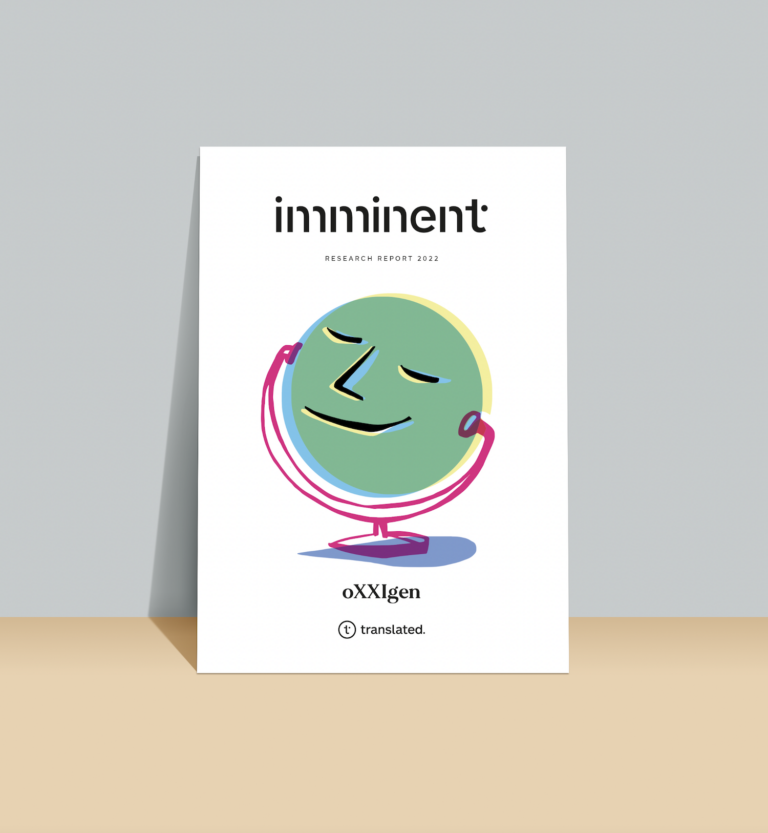Global Perspectives
Qatar is one of the most important states in the Arab world. But is Arabic the right language to do business in Qatar?
The T-Index – the index implemented by Imminent and designed to guide companies in choosing the best languages and the best markets to target – should provide a quick answer to this question. However, when discussing Qatar, more analysis is necessary from a demographic standpoint to reveal that the economic data – which indicates promising growth – is not enough on its own to offer a comprehensive overview of the country from a linguistic perspective.
The answer is complex and intricate.
The research carried out has led to a deeper insight into the complex social system of Qatar, which does not fully reflect the country’s multicultural society.

Qatar
Language Data Factbook
The Language Data Factbook project aims to make the localisation of your business and your cultural project easier. It provides a full overview of every country in the world, collecting linguistic, demographic, economic, cultural and social data. With an in-depth look at the linguistic heritage, it helps you to know in which languages to speak to achieve your goal.
Discover moreQatar boasts a place on the podium in several rankings, two of which offer a snapshot of a controversial reality in which extreme poverty and extreme wealth coexist:
- The emirate is home to 50 thousand families of millionaires, making up 14.6% of the total population.
- The emirate has the second-highest rate of population growth in the world (5.6%) not due to births, but due to the constant influx of migrant workers.
Of the 3 million people that make up the total population of Qatar, in fact, 2 million are migrant workers, who form about 95% of the total labor force. Of these, almost one million are employed in construction and 400 thousand in household work as carers. These workers come from countries like India, Nepal, the Philippines, Bangladesh, Kenya, and Uganda to seek better income opportunities.
Qatar speaks more than just Arabic.
The total population of Qatar is made up of just 10% Qataris, followed by 13% Arabs, 21.8% Indian, 7.35% Filipino, 12.5% Nepali, 12.5% Bangladeshi, 9.35% Egyptian and 4.35% Sri Lankan. Indians constitute the largest group of expats in Qatar.
This means that Qatar is home to a variety of different languages and cultures, but also that Arabic is not the first language of the majority of its inhabitants.
Qatar speaks Hindi, Filipino, Nepali, Bangla and other languages.
But it seems that the only one heard is Arabic.
Many of the migrant workers who came to Qatar hoping to earn enough to pay medical bills for sick parents, pay for children’s school fees, save up money to get married, or build homes in their countries of origin have found themselves worse off than when they left their own countries.
The conditions of these workers are often criticized by international human rights organizations.
Human Rights Watch spoke to 93 migrant workers working for 60 different employers and companies between January 2019 and May 2020, all of whom reported some form of wage abuse by their employer, such as unpaid overtime, arbitrary deductions, delayed wages, withholding of wages, unpaid wages, or inaccurate wages.
On the other side of the coin, Qatar’s quantitative progress indicators are impressive.
It is successfully seeking to move away from a rentier economy to a more knowledge-based service economy.
The 2020 GDP per capita of Qatar is listed at about 50,124 USD by the World Bank (20% less than average due to Covid-19), making it one of the highest in the world.
However, analyzing the social composition of Qatar makes it evident that this figure is accurate for Qataris (around 10% of the population), but not for the other 90% who work and live in Qatar.
Based on international criteria, poverty is almost non-existent, yet inequality and its perception not only exist but are a characteristic feature of the country’s social reality.

oXXIgen
Imminent Research Report 2022
GET INSPIRED with articles, research reports and country insights – created by our multicultural interdisciplinary community of experts with the common desire to look to the future.
Get your copy nowAccording to the World Inequality Database, there is an average income difference of €373,641 between the 50% lower-income section of the resident population and the 10% richest part of the population.
It is possible to affirm that social inequality lies in the clear distinction between Qataris and non-citizens and is especially visible in the welfare sector, since the vast majority of foreigners residing in the country are excluded from most social benefits.
In summer 2016, the Ministry of Development Planning and Statistics (MDPS) stated that roughly 60% of the country’s population, or 1.4 million people, live in what the Qatari government officially labels as “labor camps.” Many labor camps are outside the city and lack basic amenities. A significant percentage of these migrant workers are “permanently” settled, although Qatar does not consider any foreign worker as a permanent resident de jure, regardless of how long they have resided and worked there.
After years of deeply unfair policies, some small steps towards better treatment of the migrant working class were taken by the Qatari government through the implementation of laws which should guarantee a minimum wage of $275, plus the possibility of changing employers more easily through the abolition of the “kafala” system. However, these measures can only serve as a baseline, since migrant workers in Qatar still face unfavorable conditions according to Amnesty International.
Qatar’s people speak different languages, while the government of Qatar speaks one: Arabic.
The Qatari monarchy is based on a social contract that is intended to ensure political loyalty and support in exchange for the well-being of citizens.
This motivation underpins the discriminatory policies applied to all non-Qataris; it safeguards Qataris from any public spending cuts and guarantees that they will receive the best social assistance. Since the remainder of the population serves no purpose in terms of supporting the monarchy, they are subject to savings despite representing two-thirds of the population as well as 95% of the workforce.
Millions of people thus live and work in a state with rights, but where the state does not recognize their entitlement to said rights. By not recognizing the rights of migrants even though they are residents and permanent workers, in a globalized economy and an increasingly multicultural world, the country is paradoxically perpetuating the coexistence of populations that are in close physical proximity but at the same time isolated by clear-cut yet narrow borders.
Like any other country, Qatar is a place of nuances, and it is not always possible to illustrate these properly with data.
The Imminent T-Index project is an ongoing project precisely for this reason: because people move together with languages. To try to follow these movements, there are always new ways to improve it.
In particular, the T-Index study focuses on languages used to browse the Web, and the number of languages that are gaining ground on the internet is constantly on the rise.
At Imminent, we merge data with words, quantitative analysis with in-depth qualitative analysis and, thanks to our multilingual and multicultural community, we try to join the dots, filling the gaps between one data point and the next with researchers and meaningful reflections.
Qatar is home to one of these data gaps.
The only T-Index language displayed for Qatar is Arabic, but Arabs and Qataris make up just 23% of the population. The rest speak Indian, Filipino, Nepali, Bangla, and Sri Lankan. By only listing Arabic under Qatar, we omit around 80% of the country’s population.
The demographics of Qatar reveal a country in which multiculturalism and multilingualism should thrive. At the current stage, however, immigrant communities represent the lower-income section of society and are strongly limited in terms of economic growth due to low wages and strategic government policies.
On the other hand, Qataris are the wealthiest part of the population, and Arabic consequently has more weight for the T-Index – a dynamic study indicating the best country and language to expand your business. However, even taking into consideration the different purchasing power of the various cultures that live in Qatar, the data does not provide an accurate and comprehensive picture.
This is the challenging part.
This is why we are here.
To notice, to listen, to research, and finally to constantly improve thanks to our collaborative intelligence.
Imminent’s researchers raise questions, our community helps us see the nuances we would not notice alone and gives us insights from different perspectives, our data analysts work on process and data improvement, and our expert community validates studies and adds inestimable value to our work.
Where data is not enough, that’s where we can rely on collaborative intelligence.
Qatar’s language business opportunities go beyond Arabic.
The T-Index is a work in progress: it evolves as language does. You can check it out here.
Arabic
هل اللغة العربية هي اللغة الوحيدة المناسبة لممارسة الأعمال التجارية في قطر؟
تعتبر قطر واحدة من أهم الدول في العالم العربي.
ولكن هل اللغة العربية هي اللغة الوحيدة المناسبة لممارسة الأعمال التجارية في قطر؟
يمكن الحصول على إجابة سريعة على هذا السؤال بفضل مؤشر T-Index – وهو المؤشر الذي تنفذه Imminent والمصمم لتوجيه الشركات في اختيار أفضل اللغات وأفضل الأسواق التي يجب استهدافها. غير أنه عند مناقشة موضوع قطر، لا بد من إجراء المزيد من التحليل من وجهة النظر الديموغرافية للكشف عن أن البيانات الاقتصادية – التي تشير إلى نمو واعد – ليست كافية بمفردها لتقديم نظرة عامة شاملة عن البلاد من منظور لغوي.
إن الإجابة مقعدة وصعبة.
أدى البحث الذي أُجري إلى نظرة أعمق إلى النظام الاجتماعي المعقد في قطر، والذي لا يعكس بشكل كامل المجتمع متعدد الثقافات في البلد.
تتباهى قطر بمكانة ممتازة في عدة تصنيفات، يقدم اثنان منها لمحة عن واقع مثير للجدل يتعايش فيه الفقر المدقع والثروة المفرطة:
- تضم الإمارة 50 ألف أسرة من أصحاب الملايين، وهو ما يشكل 14.6% من إجمالي السكان.
- وتتمتع الإمارة بثاني أعلى معدل للنمو السكاني في العالم (5.6%) ليس بسبب الولادات، ولكن بسبب التدفق المستمر للعمال المهاجرين.
ومن بين 3 ملايين شخص يشكلون إجمالي سكان قطر، في الواقع، هناك 2 مليون عامل مهاجر، يشكلون حوالي 95% من إجمالي القوى العاملة. ومن بين هؤلاء، يعمل ما يقرب من مليون شخص في البناء و400 ألف في الأعمال المنزلية كمقدمين للرعاية. يأتي هؤلاء العمال من دول مثل الهند ونيبال والفلبين وبنغلاديش وكينيا وأوغندا للبحث عن فرص دخل أفضل.
هناك لغات مستخدمة في قطر أكثر من مجرد اللغة العربية فحسب.
يتكون إجمالي سكان قطر من 10% فقط من القطريين، ويليهم 13% من العرب، و21.8% من الهنود، و7.35% من الفلبينيين، و12.5% من النيباليين، و12.5% من البنغاليين، و9.35% من المصريين، و4.35% من السريلانكيين. ويشكل الهنود أكبر مجموعة من الوافدين في قطر.
وهذا يعني أن قطر تضم مجموعة متنوعة من اللغات والثقافات المختلفة، والأكثر أهميةً أن اللغة العربية ليست اللغة الأولى لغالبية سكانها.
تُستخدم في قطر اللغات الهندية والفلبينية والنيبالية والبنغالية ولغات أخرى.
ولكن يبدو أن اللغة الوحيدة التي تُسمع هي اللغة العربية.
فالعديد من العمال المهاجرين الذين أتوا إلى قطر على أمل كسب ما يكفي لدفع الفواتير الطبية للآباء المرضى، أو لدفع الرسوم المدرسية للأطفال، أو توفير المال اللازم للزواج، أو بناء منازل في بلدانهم الأصلية، وجدوا أنفسهم أسوأ حالاً مما كانوا عليه عندما غادروا بلدانهم.
وكثيراً ما تنتقد المنظمات الدولية لحقوق الإنسان أحوال هؤلاء العمال.
تحدثت هيومن رايتس ووتش إلى 93 عاملاً مهاجرًا يعملون لدى 60 من أصحاب الأعمال والشركات المختلفة بين يناير 2019 ومايو 2020، وأبلغوا جميعًا عن شكل من أشكال إساءة استخدام صاحب العمل للأجور، مثل العمل الإضافي غير المدفوع الأجر، أو الخصم التعسفي، أو تأخير صرف الأجور، أو حجبها، أو عدم دفعها، أو أنها غير دقيقة.
ولكن من جهة أخرى، تُعتبر مؤشرات التقدم الكمي في قطر مثيرة للإعجاب.
وهي تسعى بنجاح إلى الابتعاد عن الاقتصاد الريعي والانتقال إلى اقتصاد خدمي قائم على المعرفة بدرجة أكبر.
يبلغ نصيب الفرد من الناتج المحلي الإجمالي في قطر لعام 2020 حوالي 50124 دولارًا أمريكيًا وفقًا للبنك الدولي (20% أقل من المتوسط بسبب فيروس كورونا)، مما يجعله واحدًا من أعلى المعدلات في العالم.
ومع ذلك، يكشف تحليل التكوين الاجتماعي لدولة قطر أن هذا الرقم دقيق بالنسبة للقطريين (الذين يشكلون حوالي 10% من السكان)، ولكن ليس بالنسبة للـ 90% الآخرين الذين يعملون ويعيشون في قطر.
واستنادًا إلى المعايير الدولية، يكاد الفقر أن يكون معدومًا، ومع ذلك فإن عدم المساواة وتصورها ليسا موجودين فحسب بل يشكلان سمة مميزة للواقع الاجتماعي للبلد.
ووفقًا لقاعدة بيانات عدم المساواة في العالم، يوجد فرق في الدخل يبلغ متوسطه 373641 يورو بين 50% من الشريحة الأدنى دخلاً من السكان المقيمين و10% من الشريحة الأغنى من السكان.
ومن الممكن التأكيد على أن عدم المساواة الاجتماعية يكمن في التمييز الواضح بين القطريين وغير المواطنين ويتضح بشكل خاص في قطاع الرعاية الاجتماعية، حيث أن الغالبية العظمى من الأجانب المقيمين في البلاد مستبعدون من معظم المزايا الاجتماعية.
ففي صيف عام 2016، ذكرت وزارة التخطيط التنموي والإحصاء (MDPS) أن ما يقرب من 60% من سكان البلاد، أو 1.4 مليون شخص، يعيشون في ما تسميه الحكومة القطرية رسميًا “معسكرات العمل”. وتقع العديد من معسكرات العمل خارج المدينة وتفتقر إلى وسائل الراحة الأساسية. وقد استقرت نسبة كبيرة من هؤلاء العمال المهاجرين “بشكل دائم”، على الرغم من أن قطر لا تعتبر أي عامل أجنبي مقيمًا بشكل دائم، بغض النظر عن مدة إقامته وعمله هناك.
وبعد سنوات من السياسات المجحفة للغاية، اتخذت الحكومة القطرية بعض الخطوات الصغيرة نحو معاملة أفضل للطبقة العاملة المهاجرة من خلال تنفيذ قوانين تضمن الحد الأدنى للأجور البالغ 275 دولارًا، بالإضافة إلى إمكانية تغيير أصحاب العمل بسهولة أكبر من خلال إلغاء نظام “الكفالة”. غير أنه لا يمكن اعتبار هذه التدابير سوى خط أساس، لأن العمال المهاجرين في قطر لا يزالون يواجهون ظروفًا غير مواتية وفقًا لمنظمة العفو الدولية.
يتحدث سكان قطر لغات مختلفة، بينما تعتمد الحكومة القطرية لغة واحدة للحديث: العربية.
يستند نظام الإمارة القطري إلى عقد اجتماعي يهدف إلى ضمان الولاء السياسي والدعم في مقابل رفاه المواطنين.
ويدعم هذا الدافع السياسات التمييزية المطبقة على جميع غير القطريين؛ فهو يحمي القطريين من أي تخفيضات في الإنفاق العام ويضمن حصولهم على أفضل مساعدة اجتماعية. ونظراً لأن بقية السكان لا يخدمون أي غرض من حيث دعم نظام الحكم بالإمارة، فإنهم يخضعون للمدخرات على الرغم من أنهم يمثلون ثلثي السكان فضلاً عن 95% من القوة العاملة.
وهكذا يعيش الملايين من الناس ويعملون في دولة ذات حقوق، ولكن الدولة لا تعترف بحقهم في الحقوق المذكورة. ومن المفارقات أن عدم اعتراف البلد بحقوق المهاجرين حتى وإن كانوا مقيمين وعمالاً دائمين، في ظل اقتصاد معولم وعالم متزايد التعددية الثقافية، إنما يديم على نحو متناقض تعايش السكان الذين يعيشون بجوار بعضهم البعض ولكنهم في الوقت نفسه معزولون بحدود واضحة ولكن ضيقة.
وتُعدّ قطر، شأنها شأن أي بلد آخر، مكانًا للفروق الدقيقة، وليس من الممكن دائمًا توضيحها بشكل صحيح بالبيانات.
إن مشروع مؤشر T-Index الذي تنفذه Imminent هو مشروع مستمر على وجه التحديد لهذا السبب: لأن الناس يتحركون مع اللغات. وفي محاولة لمتابعة هذه الحركات، هناك دائمًا طرق جديدة لتحسينها.
على وجه الخصوص، تركز دراسة T-Index على اللغات المستخدمة لتصفح الويب، وعدد اللغات التي تكتسب أهميةً على الإنترنت في ارتفاع مستمر.
في Imminent، ندمج البيانات مع الكلمات، والتحليل الكمي مع التحليل النوعي المتعمق، وبفضل مجتمعنا متعدد اللغات والثقافات، نحاول وصل النقاط، وسد الفجوات بين نقطة بيانات وأخرى مع الباحثين والتفكير الهادف.
إن قطر تضم واحدة من هذه الفجوات في البيانات.
لغة T-Index الوحيدة المعروضة في قطر هي اللغة العربية، ولكن العرب والقطريين يشكلون 23% فقط من السكان. ويتحدث الباقون اللغات الهندية والفلبينية والنيبالية والبنغالية والسيريلانكيه. ومن خلال إدراج اللغة العربية فقط تحت قطر، فإننا نحذف حوالي 80% من سكان البلاد.
تكشف التركيبة السكانية في قطر عن بلد يجب أن تزدهر فيه التعددية الثقافية والتعدد اللغوي. غير أن مجتمعات المهاجرين تمثل في المرحلة الراهنة القطاع الأقل دخلاً في المجتمع وهي محدودة بشدة من حيث النمو الاقتصادي بسبب الأجور المنخفضة والسياسات الحكومية الاستراتيجية.
ومن ناحية أخرى، يشكّل القطريون الجزء الأغنى من السكان، وبالتالي فإن للغة العربية وزن أكبر في T-Index – وهي دراسة ديناميكية تشير إلى أفضل بلد ولغة لتوسيع عملك. ومع ذلك، وحتى مع مراعاة القوة الشرائية المختلفة للثقافات المتنوعة التي تعيش في قطر، فإن البيانات لا تقدم صورة دقيقة وشاملة.
وهذا هو الجزء الصعب.
ولهذا السبب نحن موجودين هنا.
للملاحظة والاستماع والبحث، وأخيرا للتحسين باستمرار بفضل ذكاءنا التعاوني.
يثير الباحثون في Imminent أسئلة، ويساعدنا مجتمعنا على رؤية الفروق الدقيقة التي لن نلاحظها بمفردنا وتعطينا رؤى من وجهات نظر مختلفة، ويعمل محللو البيانات لدينا على تحسين العمليات والبيانات، ويصادق مجتمع خبرائنا صحة الدراسات ويضيف قيمة لا تقدر بثمن لعملنا.
عندما لا تكون البيانات كافية، يمكننا الاعتماد على الذكاء التعاوني.
إن فرص الأعمال اللغوية في قطر تتجاوز اللغة العربية.
يعتبر T-Index عملًا قيد التنفيذ:
إنه يتطور كما تتطور اللغة.
يمكنك التحقق من ذلك على موقع Imminent على الإنترنت.
Photo credits: Elissar Haidar, Unsplash
